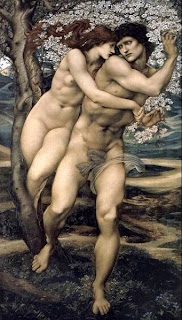__Salmacis_and_Hermaphroditus__c__1585,_Borghese,_Rome.jpg) Scareselino Salmacis and Hermaphroditus (ca 1585)
Scareselino Salmacis and Hermaphroditus (ca 1585) Francesco Albani Salmacis kissing Hermaphroditus (ca 1660)
Francesco Albani Salmacis kissing Hermaphroditus (ca 1660) Francesco Albani Salmacis Falling in Love with Hermaphroditus (ca 1660)
Francesco Albani Salmacis Falling in Love with Hermaphroditus (ca 1660) François-Joseph Navez The Nymph Salmacis and Hermaphroditus (1829)
François-Joseph Navez The Nymph Salmacis and Hermaphroditus (1829) Jean Francois de Troy Salmacis and Hermaphroditus
Jean Francois de Troy Salmacis and Hermaphroditus Edward Burne Jones Salmacis and Hermaphroditus
Edward Burne Jones Salmacis and Hermaphroditus .
In ancient art Hermaphroditus, either specifically or as a generalized type, is a common subject. He is either nude or lifts his garment to expose his genitals; alternatively, a satyr, who mistakes him for a woman, assaults him. The most famous portrayal represents Hermaphroditus asleep, lying on his stomach, head turned to the side, and torso twisted just enough to reveal his breast and genitals. (National Museum of the Terme, Rome, and the Louvre, Paris.)
Hermaphrodites disappear from post-classical art history until the Renaissance, when writers of alchemical treatises rediscovered them as non-erotic symbols for the union of opposites (a potent image for later Jungian psychology), and emblem books portrayed them as symbols of marriage.
The tale of Hermaphroditus and Salmacis was portrayed occasionally in Renaissance and Neoclassical art. (glbtq.com)
In ancient art Hermaphroditus, either specifically or as a generalized type, is a common subject. He is either nude or lifts his garment to expose his genitals; alternatively, a satyr, who mistakes him for a woman, assaults him. The most famous portrayal represents Hermaphroditus asleep, lying on his stomach, head turned to the side, and torso twisted just enough to reveal his breast and genitals. (National Museum of the Terme, Rome, and the Louvre, Paris.)
Hermaphrodites disappear from post-classical art history until the Renaissance, when writers of alchemical treatises rediscovered them as non-erotic symbols for the union of opposites (a potent image for later Jungian psychology), and emblem books portrayed them as symbols of marriage.
The tale of Hermaphroditus and Salmacis was portrayed occasionally in Renaissance and Neoclassical art. (glbtq.com)















1 σχόλιο:
Τι απελπισμένος που δείχνει ο ερμαφρόδιτος σε όλους τους πίνακες!
Δημοσίευση σχολίου